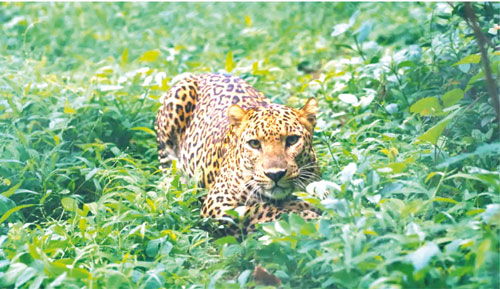The scenic and ever rejuvenating biodiversity-rich Margalla Hills National Park has become home to the endangered Common Asian Leopards strolling on the trails of the national park where it needs public awareness and sensitisation to avert the looming risk of human-wildlife conflict.
Senior Islamabad Wildlife Management Board Member Z.B. Mirza has prepared a special education and awareness manual for the locals and tourists venturing into the National Park to enjoy the natural beauty of the Park.
There has been no precedent of human-wildlife conflict in Margalla Hills National Park as the wildcat has a stable number of prey available in the natural environment.
There are almost 62 different species of wildlife on the menu of the wildcat that leads the food chain of the national park as the apex predator. According to Z.B. Mirza’s information manual the leopards though have no history of attacking any human in the Margallas but the wildcat in 2005 killed six women in different incidents in Galiyat areas falling under the Ayubia National Park.
The Asian Leopard is a nocturnal animal that fully activates at night or wee hours of morning to predate or hunt, and patrol. It feeds mainly on Barking Deers, Porcupines, Wild Boars, livestock animals, Donkeys, Monkeys, birds, Kalij Pheasant and others.
A detailed study of the women killed in different leopard attacks revealed that they were off to the jungle to collect fuelwood during evening and early morning hours.
The user guide manual that is equally helpful for locals, tourists, trekkers and area guides underlined that the local community people should avoid entering the jungle or forest area during early morning or evening hours as the Leopard remains active in this duration.
The local residents should keep a tubelight or bulb on at night, keep livestock including goats locked at a safer place at night, and should be accompanied by some individual for livestock rearing in the woods. The women and children should be forbidden to enter the jungle alone where the former should go in groups to collect fuelwood. Moreover, the individuals in the forest should talk loudly and incase of a group one of them should be placed to guard the surrounding. The individuals entering into the forests should keep a club with them and keep on talking in a loud voice especially in the evening and morning hours.
In case of any encounter with the Leopard in the wild, it is imperative for the individual to remain composed and patient instead shouting and running in fear as this reaction will be similar to that of the leopard’s prey. The individual rather step backward and leave the area slowly. If an individual hears growling sounds of Leopard then he or she must avoid intruding further into the jungle area.
Furthermore, if a female leopard is spotted with her cubs then it necessary to avoid entering or passing into that area. In case of a very close encounter with the leopard then the individual should clap with his or her both hands and should move his arms or shawl to show him or herself bigger than the wildcat. Vice President, Pakistan Wildlife Foundation Safwan Ahmed told that internationally there were professional tourist guides entering into the Leopard area.
“The tourists are tagged with transmitters to get their realtime location and are also sent into safe areas or zones in the forests”. He added that there was no population record of leopards earlier in the Margalla Hills National Park but recent studies had revealed a sizeable population of wildcats that needs to be managed wisely to avoid human-wildlife contact.







